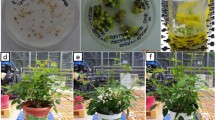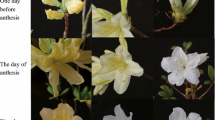Abstract
To establish a model system for alteration of flower color by carotenoid pigments, we modified the carotenoid biosynthesis pathway of Lotus japonicus using overexpression of the crtW gene isolated from marine bacteria Agrobacterium aurantiacum and encoding β-carotene ketolase (4,4′-β-oxygenase) for the production of pink to red color ketocarotenoids. The crtW gene with the transit peptide sequence of the pea Rubisco small subunit under the regulation of the CaMV35S promoter was introduced to L. japonicus. In most of the resulting transgenic plants, the color of flower petals changed from original light yellow to deep yellow or orange while otherwise exhibiting normal phenotype. HPLC and TLC analyses revealed that leaves and flower petals of these plants accumulated novel carotenoids, believed to be ketocarotenoids consisting of including astaxanthin, adonixanthin, canthaxanthin and echinenone. Results indicated that modification of the carotenoid biosynthesis pathway is a means of altering flower color in ornamental crops.








Similar content being viewed by others
References
Cunningham FX Jr, Gantt E (2005) A study in scarlet: enzymes of ketocarotenoid biosynthesis in the flowers of Adonis aestivalis. Plant J 41:478–492
Forkmann G, Martens S (2001) Metabolic engineering and application of flavonoids. Curr Opin Biotech 12:155–160
Fraser PD, Romer S, Shipton CA, Mills PB, Kiano JW, Misawa N, Drake RG, Schuch W, Bramley PM (2002) Evaluation of transgenic tomato plants expressing an additional phytoene synthase in a fruit-specific manner. Proc Natl Acad Sci USA 99:1092–1097
Hischberg J (2001) Carotenoid biosynthesis in flowering plants. Curr Opin Plant Biol 4:210–218
Kajiwara S, Kkizono T, Saito T, Kondo K, Ohtani T, Nishino N, Nagai S, Misawa N (1995) Isolation and functional identification of a novel cDNA for astaxanthin biosynthesis from Haematococcus pluvialis, and astaxanthin synthesis in Escherichia coli. Plant Mol Biol 29:343–352
Kato M, Ikoma Y, Matsumoto H, Sugiura M, Hyodo H, Yano M (2004) Accumulation of carotenoids and expression of carotenoid biosysnthetic gene during maturation in citrus fruit. Plant Physiol 134:824–838
Mann V, Harker M, Pecker I, Hirschberg J (2000) Metabolic engineering of astaxanthin production in tobacco flowers. Nat Biotechnol 18:888–892
Misawa N, Yamano S, Linden H, de Felipe MR, Lucas M, Ikenaga H, Sandmann G (1993) Functional expression of the Erwinia uredovora carotenoid biosynthesis gene crtI in transgenic plants showing an increase of β-carotene biosynthesis activity and resistance to the bleaching herbicide norflurazon. Plant J 4:833–840
Misawa N, Satomi Y, Kondo K, Yokoyama A, Kajiwara S, Saito T, Ohtani T, Miki W (1995) Structure and functional analysis of a marine bacterial carotenoid biosynthesis gene cluster and astaxanthin biosynthetic pathway proposed at gene level. J Bacteriol 177:6575–6585
Morris WL, Ducreuxa LJM, Fraserb PD, Millam S, Taylor MA (2006) Engineering ketocarotenoid biosynthesis in potato tubers. Metab Eng 8:253–263
Murashige T, Skoog F (1962) A revised medium for rapid growth and bioassays with tobacco tissue cultures. Physiol Plant 15:437–497
Noda K, Glover BJ, Linstead P, Martin C (1994) Flower colour intensity depends on specialized cell shape controlled by a Myb-related transcription factor. Nature 369:661–664
Ralley L, Enfissi EMA, Misawa N, Schuch W, Bramley PM, Fraser PD (2004) Metabolic engineering of ketocatenoid formation in higher plants. Plant J 39:477–486
Rock CD, Zeevaart JAD (1991) The aba mutant of Arabidopsis thaliana is impaired in epoxy-carotenoid biosynthesis. Proc Natl Acad Sci USA 88:7496–7499
Rosati C, Aquilani R, Dharmapuri S, Pallara P, Marusic C, Tavazza R, Bouvier F, Camara B, Giuliano G (2000) Metabolic engineering of bete-carotene and lycopene content in tomato fruit. Plant J 24:413–419
Shewmaker CK, Sheehy JA, Daley M, Colburn S, Ke DY (1999) Seed-specific overexpression of phytoene synthase: increase in carotenoids and other metabolic effects. Plant J 20:401–412
Stalberg K, Lindgren O, Ek B, Hoglund AS (2003) Synthesis of ketocarotenoids in the seed of Arabidopsis thaliana. Plant J 36:771–779
Tanaka Y, Tsuda S, Kusumi T (1998) Metabolic engineering to modify flower color. Plant Cell Physiol 39:1119–1126
Thomson WW, Whatley JM (1980) Development nongreen plastids. Annu Rev Plant Physiol 31:357–394
Van Houwelingen A, Souer E, Spelt K, Kloos D, Mol J, Koes R (1998) Analysis of flower pigmentation mutants generated by random transposon mutagenesis in Petunia hybrida. Plant J 13:39–50
Vishnevetsky M, Ovadis M, Vainstein A (1999) Carotenoid sequestration in plants: the role of carotenoid-associate proteins. Trends Plant Sci 4:232–235
Ye X, Al-Babili S, Kloti A, Zhang J, Lucca P, Beyer P, Potrykus I (2000) Engineering the provitamin A (-carotene) biosynthetic pathway into (carotenoid-free) rice endosperm. Science 287:303–305
Zsila F, Deli J, Simonyi M (2001) Color and chirality: carotenoid self-assemblies in flower petals. Planta 213:937–942
Acknowledgements
We thank Dr. Toshio Aoki, Nihon University, for providing the seeds of L. japonicus and technical advice on plant transformation. We also thank Ms. Yoshiko Abe and Akiko Kubota for technical assistance.
Author information
Authors and Affiliations
Corresponding author
Additional information
Communicated by G.C. Phillips.
Rights and permissions
About this article
Cite this article
Suzuki, S., Nishihara, M., Nakatsuka, T. et al. Flower color alteration in Lotus japonicus by modification of the carotenoid biosynthetic pathway. Plant Cell Rep 26, 951–959 (2007). https://doi.org/10.1007/s00299-006-0302-7
Received:
Revised:
Accepted:
Published:
Issue Date:
DOI: https://doi.org/10.1007/s00299-006-0302-7




